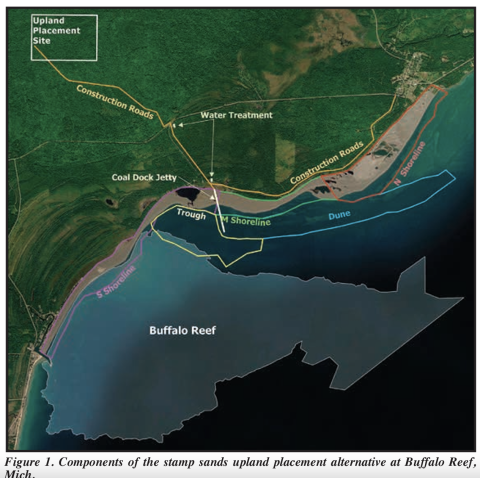
By Esteban Chiriboga & Jennifer Vanator GLIFWC Staff
Gay, Mich.—The almost two-decade long effort to address contamination from mine tailings along the eastern shore of the Keweenaw Peninsula takes a major step forward with the release of the Final Alternatives Analysis report. This past January the Buffalo Reef Task Force (BRTF) released the Final report, which outlines all alternatives that were proposed and analyzed for addressing the encroachment of mine tailings, or stamp sands, onto Buffalo Reef and its associated whitefish and lake trout spawning areas. GLIFWC staff have been providing technical and scientific support to the Task Force, made up of the Keweenaw Bay Indian Community; the Army Corps of Engineers; The Michigan Department of Environment, Great Lakes, and Energy; and the U.S. Environmental Protection Agency to identify a preferred alternative. The upland placement alternative has emerged as the preferred option. This alternative would construct a new landfill in an upland location close to the shoreline that would store dredged stamp sands from the impacted shoreline and underwater locations. A major component of this alternative is the construction of a jetty at the location of an old coal dock. This jetty would be used as a collection point to load dredged stamp sands on trucks for transport to the landfill.
The jetty would also act as a sand trap that would prevent stamp sands located to the north from re-contaminating the areas restored by dredging to the south. Under this alternative, stamp sands would be dredged from impacted areas on Buffalo Reef and from shoreline areas north of the Traverse River Harbor for many years. The areas labeled “S shoreline” and “Trough” in Figure 1 would be dredged first. This will ensure protection of Buffalo Reef and continued safe navigation at the harbor. Areas labeled “Dune,” “M Shoreline,” and “N Shoreline” would be restored towards the end of the project. The final alternatives report also includes detailed biology and fishery data and analyses conducted over the many years of project development, details on cost and economics of the project, and engineering designs. It is important to note that the project is designed to be completed in phases to allow considerable flexibility in project implementation given the challenges of finding funding to complete the entire project all at once.
The next major step is to locate funding. GLIFWC staff continues to work with congressional and agency staff to allocate resources to this important restoration project. The BRTF is currently reviewing public comments on the final alternatives report. The comment period wrapped up March 1. Learn more at: michigan.gov/dnr/managing-resources/fisheries/units/buffalo-reef.